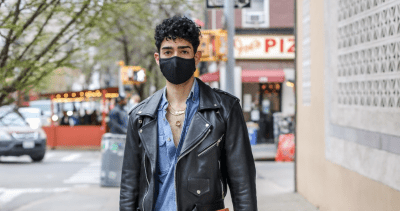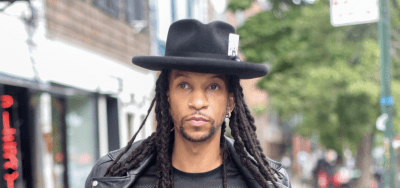Mock (Ye-ah!) Ing (Ye-ah!) Jay (Ye-ah!) PartOne (Ye-ah!)

‘The Hunger Games’ series is set in a dystopia in which the fight for survival is televised spectacle.
When we last left Katniss Everdeen (Jennifer Lawrence), she was waking up in an airplane after unexpectedly evading death in her second Hunger Games, the annual event designed to keep the various districts of the dystopian Pan-Em under control of the nefarious Capitol (you may know the story by now). Specifically, director Francis Lawrence (no relation) finished off Catching Fire, the second film in the series, with his camera tight on his star’s face, watching it harden from grief over her destroyed home district into the beginnings of righteous anger.
Lawrence and Lawrence both return for Mockingjay – Part 1 and there, in those two words, sits the rub. In the book trilogy by Suzanne Collins, Mockingjay is the least-loved and unfairly maligned final installment that dispenses with the Hunger Games all together and follows Katniss and company into a national uprising. Though a little repetitive (and written in the Collins prose style, which sounds stripped down by a damage-controlling editor more than by an economical writer), the book is smart and unsparing about the psychological costs of revolution. It could have been pared into a hell of a single film, and based on Catching Fire, an exciting movie made from the trilogy’s weakest book, Lawrence could have been the one to help do that. Instead, the final book has been cleaved into two films, as has become the style—a creative decision that effectively chops off the movie’s legs right before it begins training for a final sprint.
The best case scenario when a book is amputated thusly would be the one that kick-started this trend: the first half of Harry Potter and the Deathly Hallows. It didn’t have much of an ending—how could it?—but the extra running time allowed director David Yates to stretch out and let his enormous cast of characters breathe, and sustain a mood less interrupted by climactic pyrotechnics. Some of the most tedious passages of the book, with the central characters wandering in the woods looking for clues, became some of the best in the film series.
There’s a little bit of that spirit in Mockingjay. No longer training for or fighting in a death arena, Katniss is recruited by the rebellion’s President Coin (Julianne Moore) and right-hand man Plutarch (Philip Seymour Hoffman, in one of his final roles) to be the face of the revolution, capitalizing on her mad Hunger Fames. Meanwhile, her maybe-true maybe-love Peeta (Josh Hutcherson) is stuck in the Capitol, doing the same for President Snow (Donald Sutherland). The negotiation of Katniss’s symbolism provides some of the best, most surprising material in the movie. Hoffman gives Plutarch a subtly wily smile that didn’t come across on the page, while Effie Trinket (Elizabeth Banks), her role expanded from the third book, turns up to help design the propaganda (Katniss, she notes, will be the “best-dressed rebel in history”), along with a welcome if slightly underused Haymitch (Woody Harrelson). And widely beloved, thrice-nominated Oscar-winner Jennifer Lawrence gets a killer scene where she gets to reveal that Katniss, for all of her bravery and honesty (or maybe because of it) is a pretty bad actress.
More than some other half-movies dictated by franchise expansion, this one feels like an experiment: can we make a big-canvas blockbuster about the grim (and sometimes grimly funny) process of mounting a revolution? It would’ve been a great challenge for Steven Soderbergh, one-time second-unit director for a sequence in the first movie; he comes to mind not just because of his interest in process and problem-solving, but because Mockingkay – Part 1 begins dabbling in the kind of sickly brown-ish/yellow-ish color palette Soderbergh has employed in the past. Francis Lawrence, though a more accomplished technician than series originator Gary Ross, is not quite Steven Soderbergh. As in Catching Fire, he composes some striking images, like the unbroken shot of Katniss hiding in the dark after a nightmare, and a recurring motif of following J-Law with a handheld camera. But just as often, the good stuff is intercut with more rote blockbuster coverage. The movie is never incompetent, but it sometimes feels visually muted.
When the movie toys with Pan-Em politics, this doesn’t matter so much, for the opposite reason that it didn’t matter so much when Catching Fire gave way to some handsomely mounted, IMAX-shot action scenes in its back half. Mockingjay – Part 1, by contrast, is missing its back half; it’s waiting in the editing bay and titled Mockingjay – Part 2. This leaves the movie fudging a scene where Katniss essentially watches mostly-anonymous other characters (if I haven’t yet mentioned Liam Hemsworth’s Gale, well, carry on) on a mission cut like the outline of an exciting action sequence into a de facto climax. At its best, this half-Mockingjay details a kind of unhealthy propaganda therapy as Katniss and Peeta head toward their inevitable reunion. But it’s not really enough to sustain a satisfying two-hour feature, even if Lawrence ‘n Lawrence—J-Law being as steely and compelling as ever—bring it pretty damn close.
Mockingjay Part 1, like its predecessor, departs on Lawrence’s face, in an arresting shot more visually complex than the simple close-up that ended Catching Fire. But the previous movie’s cliffhanger snapped to black with just enough emotional transition to give it a modicum of closure. This one composes an image that should crystallize the story, before telling the audience we’ll pick it up again in a year.
You might also like 



















